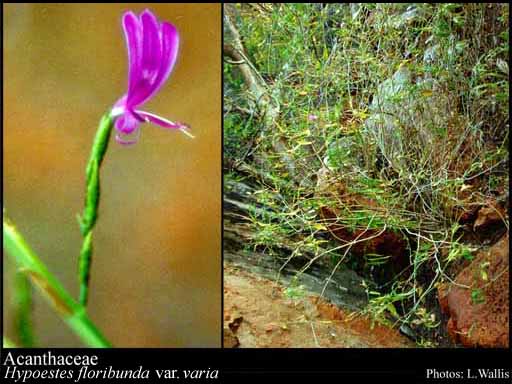- Reference
- Gen.Pl. [Jussieu] 102 (1789)
- Name Status
- Current

Scientific Description
Common name. Acanthus Family.
Habit and leaf form. Shrubs, or herbs, or trees (rarely). ‘Normal’ plants, or switch-plants (rarely). Leaves well developed (usually), or much reduced. The herbs annual to perennial; plants with a basal concentration of leaves, or with neither basal nor terminal concentrations of leaves. Self supporting (mostly, by contrast with Thunbergiaceae), or epiphytic, or climbing (sometimes, e.g Adhatoda); when climbing, stem twiners, or root climbers, or scrambling. The twiners twining clockwise. Trees leptocaul. Hydrophytic, or helophytic (including a few mangroves), or mesophytic (many in damp places in tropical forests), or xerophytic. Leaves opposite (decussate); gland-dotted, or not gland-dotted; simple. Leaf blades dissected, or entire; flat; pinnately veined; cross-venulate. Leaves without stipules. Leaf blade margins entire, or crenate, or serrate, or dentate; flat, or revolute, or involute. Domatia recorded (from 3 genera); represented by hair tufts. Stem anatomy. Nodes unilacunar. Secondary thickening developing from a conventional cambial ring. Roots. Aerial roots present, or absent.
Reproductive type, pollination. Fertile flowers hermaphrodite. Unisexual flowers absent. Plants hermaphrodite. Entomophilous. Pollination mechanism conspicuously specialized (commonly exhibiting a loose-pollen mechanism, cf. Scrophulariaceae etc. — e.g. the large bee-flowers of Acanthus), or unspecialized.
Inflorescence and flower features. Flowers solitary, or aggregated in ‘inflorescences’; in cymes, in racemes, and in verticils. The terminal inflorescence unit cymose (in about 75%), or racemose. Inflorescences commonly dichasial cymes, becoming monochasial in the ultimate branches, and frequently condensed in the leaf axils, cf. Labiatae; pseudanthial, or not pseudanthial. Flowers bracteate; bracteolate (the bracts and bracteoles often showy); somewhat irregular to very irregular (in about 75% of the genera), or regular; usually more or less zygomorphic. The floral asymmetry involving the perianth and involving the androecium. Flowers 4 merous, or 5 merous; tetracyclic. Free hypanthium absent. Hypogynous disk present. Perianth with distinct calyx and corolla; (6–)8, or 10; 2 -whorled; isomerous, or anisomerous. Calyx (3–)4, or 5; 1 -whorled; gamosepalous; entire, or lobed; variously lobulate, or blunt-lobed; imbricate, or valvate, or contorted, or open in bud. Degree of gamosepaly, maximum length joined/total calyx length 0.5–0.9. Calyx when K5, with the median member posterior. Corolla 4, or 5; 1 -whorled; gamopetalous (at least basally). Degree of gamopetaly 0.5–0.75. Corolla imbricate, or contorted, or with open aestivation (in Acanthus only); bilabiate, or unequal but not bilabiate (the upper lip sometimes suppressed). Androecium 2, or 4(–5). Androecial members adnate (usually exserted, the filaments inserted on the corolla tube); all equal, or markedly unequal; free of one another, or coherent; when coherent, 2 - adelphous (partially connate, in pairs); 1 -whorled. Androecium exclusively of fertile stamens, or including staminodes. Staminodes when present, 1–3. Stamens 4(–5), or 2; didynamous (in about 75% of the species), or not didynamous, not tetradynamous; reduced in number relative to the adjacent perianth, or isomerous with the perianth; oppositisepalous; all alternating with the corolla members. Anthers separate from one another, or connivent; dorsifixed (often with one lobe reduced or abortive); dehiscing via longitudinal slits; unilocular to bilocular; tetrasporangiate; appendaged (the connective often long, cf. Salvia), or unappendaged. Pollen shed as single grains. Gynoecium 2 carpelled. The pistil 2 celled. Gynoecium syncarpous; synstylovarious to eu-syncarpous; superior. Ovary plurilocular; 2 locular. Gynoecium median. Ovary sessile. Styles 1; attenuate from the ovary; apical; much longer than the ovary at anthesis (usually). Stigmas 2 (the posterior often smaller); dry type; non-papillate; Group II type. Placentation axile. Ovules 2–50 per locule (i.e., 2 to many); non-arillate, or arillate (occasionally exhibiting what may be a funicular aril - cf. Corner); anatropous to campylotropous.
Fruit and seed features. Fruit non-fleshy; dehiscent; a capsule. Capsules loculicidal. Fruit elastically dehiscent. Dispersal unit the seed. Seeds non-endospermic; borne on minute, hook-like outgrowths (‘retinacula’); conspicuously hairy, or not conspicuously hairy; with amyloid, or without amyloid. Embryo well differentiated. Cotyledons 2. Embryo achlorophyllous (3/3); large. Testa sometimes covered with hairs or scales which become sticky or slimy when wet. Seedling. Germination phanerocotylar.
Physiology, biochemistry. Aluminium accumulation not found. Photosynthetic pathway: C3, or C4.
Special features. The seeds on elongated, indurated, hook-shaped funicles (‘retinacula’). Mangroves (a few), or non-mangrove species.
Geography, cytology, number of species. Holarctic, Paleotropical, Neotropical, Cape, and Australian. World distribution: centred on Indomalaysia, Africa, Brazil and central America. X = 7–21. 2500 species.
Economic uses, etc. A few cultivated ornamentals: Acanthus, Aphelandra, Fittonia, Beloperone, Justicia etc.
Keys
Western Australian Genera and Families of Flowering Plants — an interactive key
T.D. Macfarlane, L. Watson, N.G. Marchant